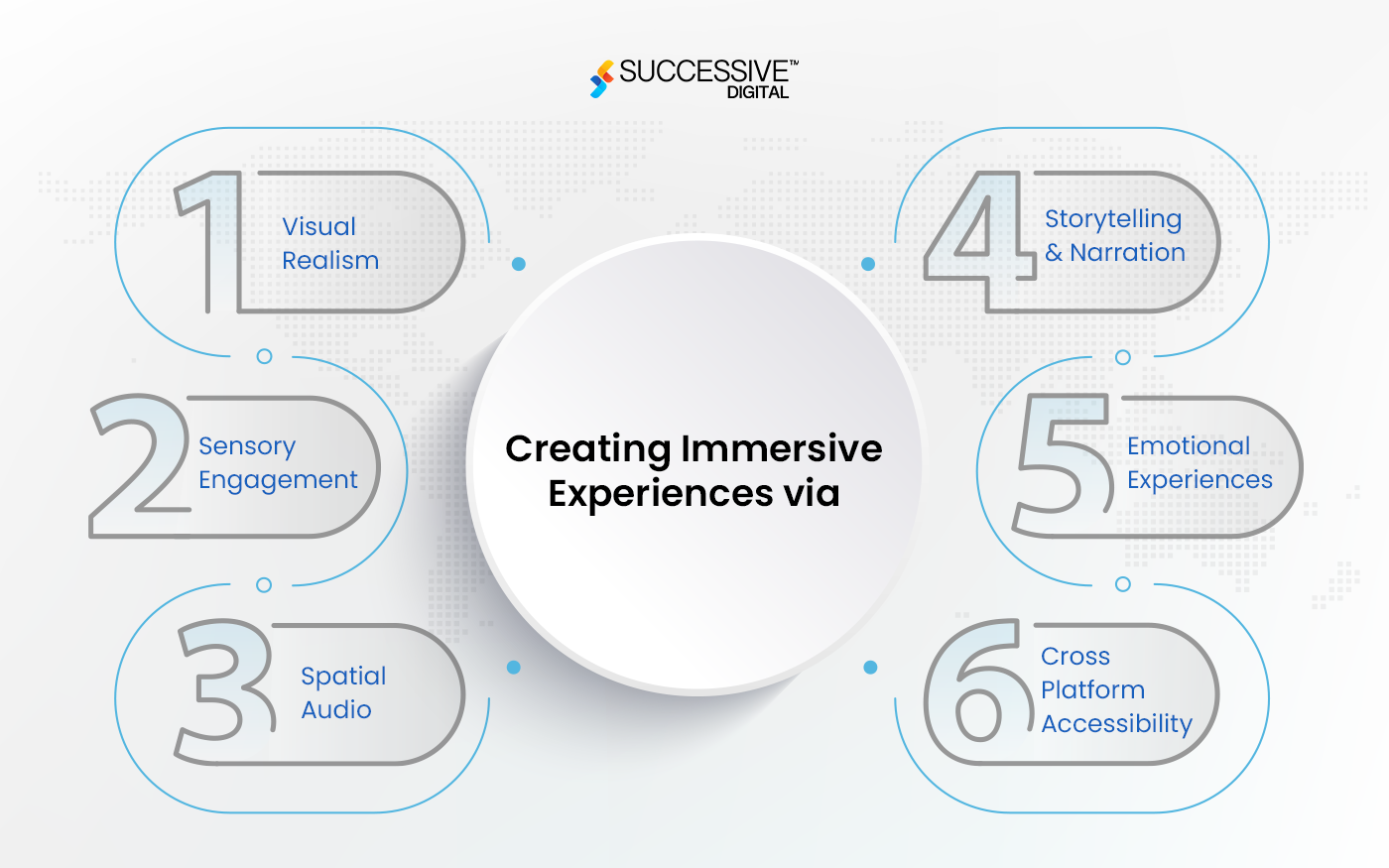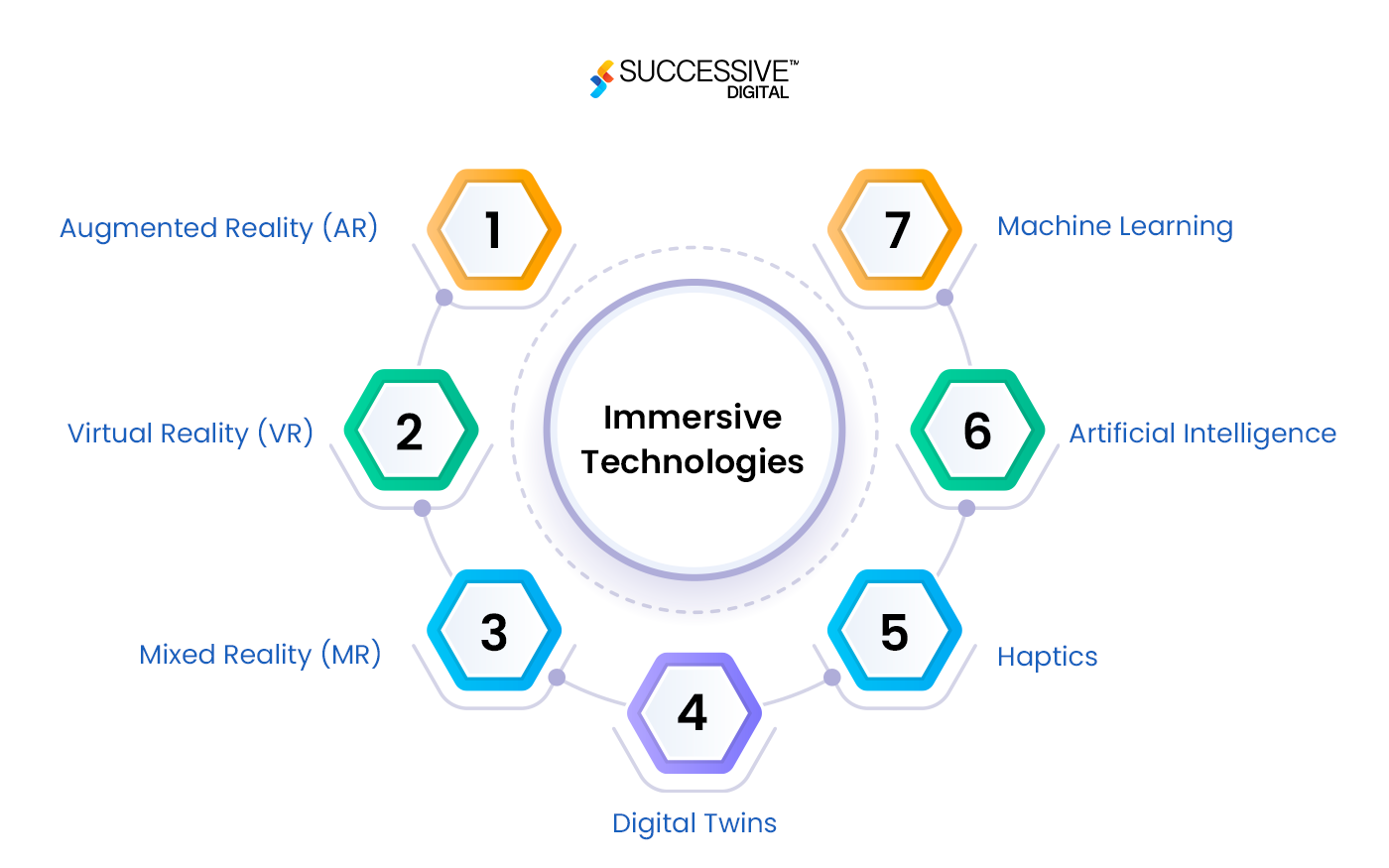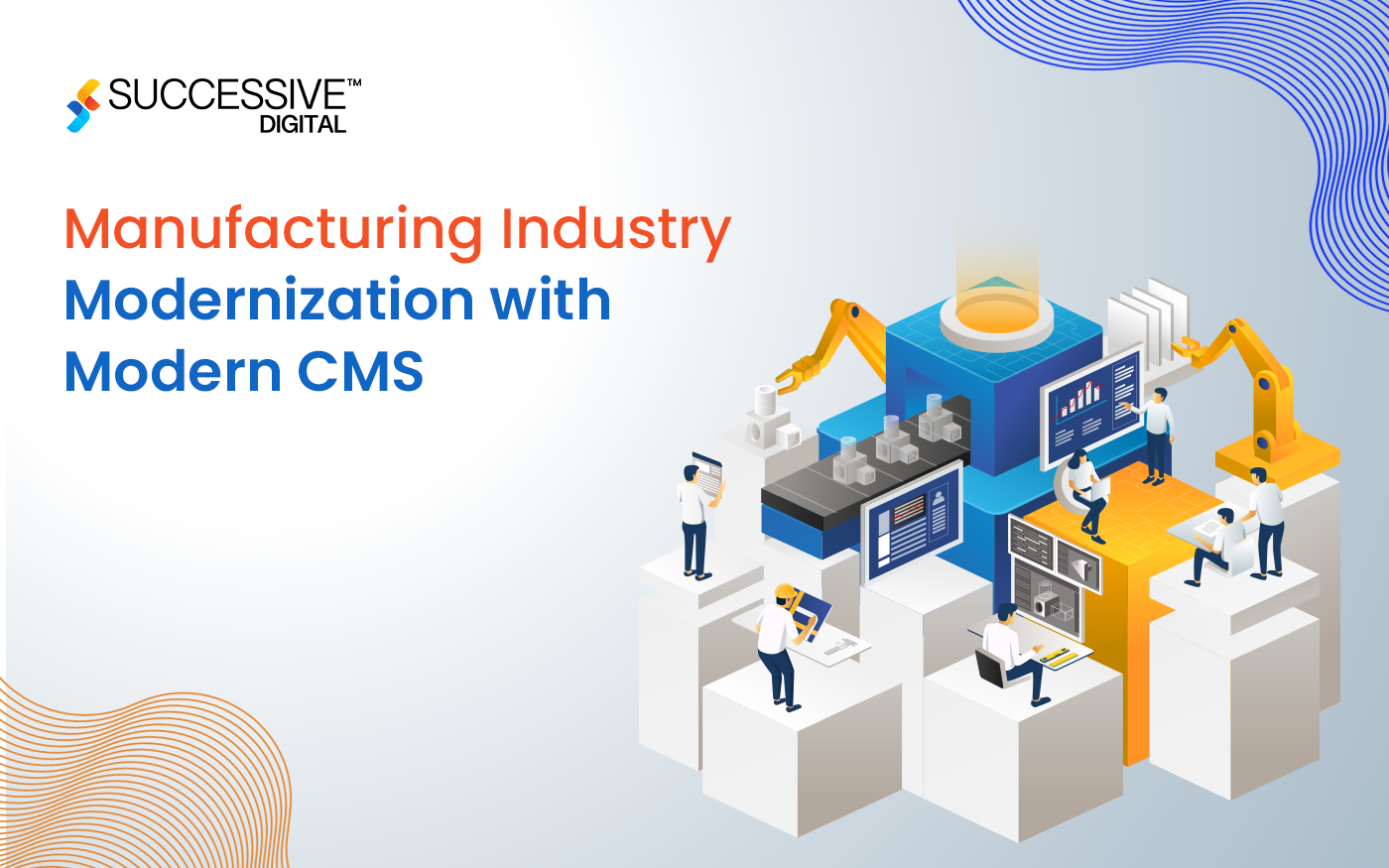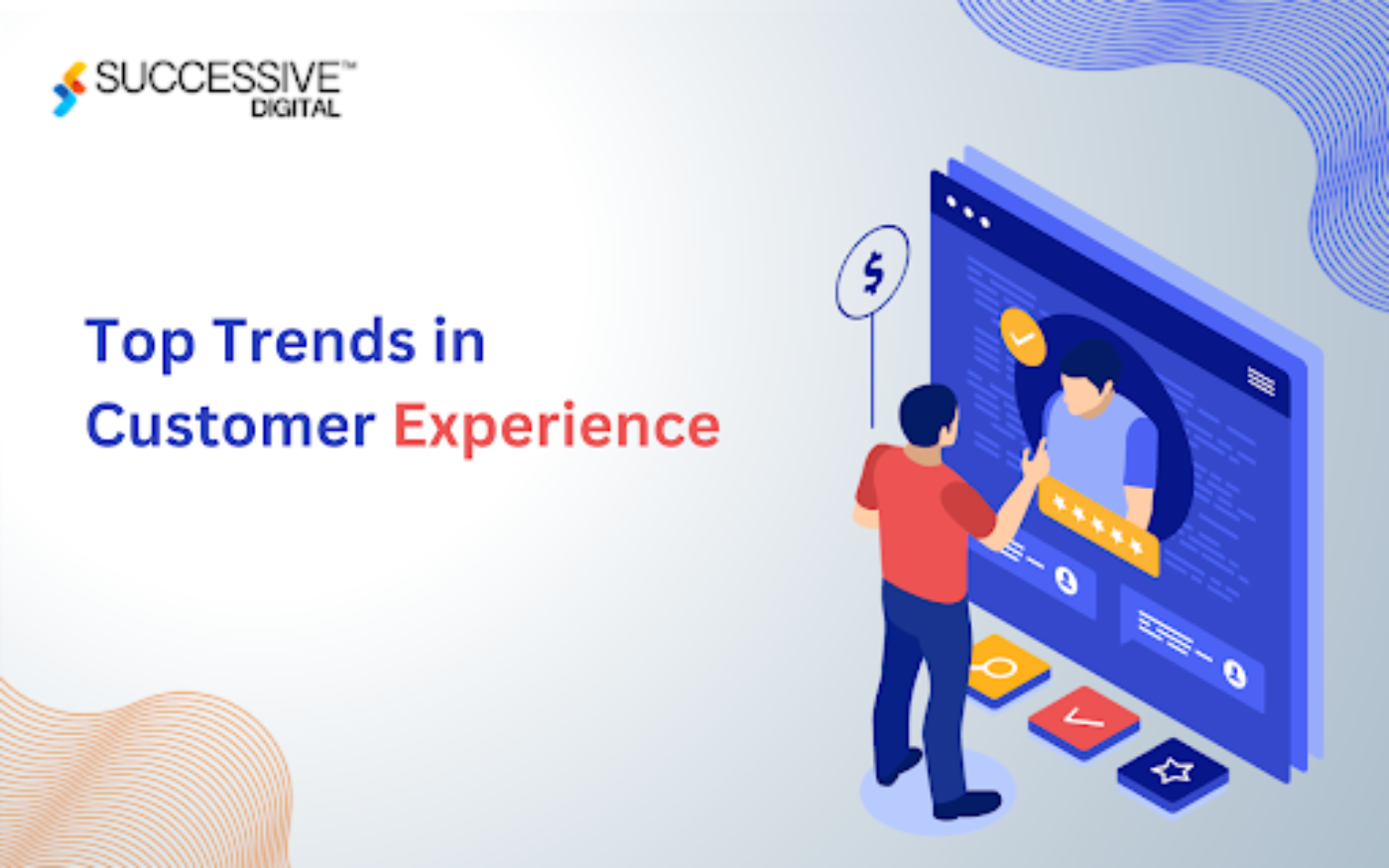Most people immediately think of virtual or augmented reality when asked about 3D experiences. However, it’s time to expand our horizons as businesses deal with the expectations and demands of future customers in CX today.
CX has become crucial to businesses’ growth and success journey. A large part of CX is comprised of immersive experiences. These experiences have created a world of new opportunities. They have introduced new horizons that have completely transformed the reality of interaction and engagement.
With present-day technological advancements, immersive experiences can be deployed on the web, mobiles, tablets, laptops, and head-mounted displays, making them omnichannel. Furthermore, immersive experiences created via advanced technologies like 3D, augmented, virtual, and mixed reality, have transformed user engagement and created a larger-than-life experience.
This blog will serve as a comprehensive guide to immersive experiences, how they affect different businesses, and how you can leverage them to your advantage in the internet world.
What is an Immersive Experience?
An “immersive experience” introduces a person to a new world of reality, improving ordinary scenarios (by making them more engaging or rewarding) with technology.
Immersive Experiences are a way to connect with customers deeply emotionally.
Unlike augmented reality, which adds digital features to the existing world, immersive experiences take users to new environments or narratives. These experiences engage numerous senses, foster emotional connections, and generate long-lasting memories. Immersive experiences are complete sensory experiences created via advanced technology.
In a simple way, An experience that engages the senses and gives the person the impression that they are a part of the event rather than merely a spectator is an immersive experience. An immersive experience involves taking the user to a new location, period, or space where they can engage with the setting and the characters. Various media, including 360-degree movies, augmented reality, virtual reality, interactive installations, and live performances, can create immersion.
For example – Beat Saber is a virtual reality game. In this game, the user slices through blocks to the beat of the music while wielding two laser swords in virtual reality. The immersive experience immerses the player in the action as they dodge incoming assaults and slice through barriers.
Similarly, Sleep No More also offers an immersive experience. The audience can explore a multi-level setting and engage with actors portraying scenes from Shakespeare’s Macbeth in an interactive theater presentation. Rather than merely witnessing the play from a distance, the audience member becomes a part of the narrative and experience it as though they are inside the scene.
What is Augmented Reality?
The term “augmented reality” (AR) refers to a technologically-delivered, improved representation of the real world that incorporates digital visuals, audio, and other senses. Businesses engaged in mobile computing and business apps, in particular, are seeing an increase in this trend.
One of the main objectives of augmented reality is to draw attention to particular aspects of the physical environment, deepen our comprehension of those qualities, and extract astute and easily understandable knowledge with practical applications. Additionally, big data can assist businesses in making decisions and provide insight into the purchasing patterns of their customers.
What is Virtual Reality?
The term virtual reality refers to the three-dimensional, artificially generated environment with advanced computing technologies. This creates an artificial environment in which humans can interact with humans. That person becomes a part of this virtual world or is immersed in this environment. Moreover, while being there, they can handle items or perform a sequence of tasks.
It is a simulated 3D environment in which users can interact with a computing environment in a manner comparable to how they perceive reality through their senses. The environment is created using computer hardware and software, but individuals may need protective gear such as helmets or goggles to interact with it. The more deeply people can immerse themselves in a VR experience — and block out their physical surroundings — the more they can suspend disbelief and accept it as real, no matter how bizarre it is.
How to Create Immersive Experiences?
Immersive Experiences are so much more than what one can think. Creating immersive experiences is becoming increasingly popular these days. Whether you’re making a website, an app, a game, or a virtual reality experience, the ability to create an immersive atmosphere can distinguish your work from the competition. An immersive experience can engage consumers deeper, making them feel like they are a part of the experience rather than simply watching it. Below are the key elements that makes an immersive experience complete:
-
Visual Realism
When it comes to immersive experiences, visual realism produces realistic images while also making sure they correspond with actual events. When it comes to fall, the way the leaves change color and light and shadow interact should be similar to what one would see in autumn. This degree of visual fidelity encourages connection and genuineness. A sensory environment gets created and builds up memory.
-
Sensory Engagement
Sensory engagement is more than just sight. Using senses other than vision to appeal to customers is known as sensory engagement. Fostering a more comprehensive and memorable connection improves the customer experience (CX). Customers who engage in sensory engagement during immersive events feel physically present in the setting. For example, a client from another region takes part in group discussions. A rich, multimodal experience is enhanced by seeing him present in the environment and a multistorey office view.

-
Spatial Audio
Replicating how sounds interact in a physical place, spatial audio enhances CX with even another level of depth. For example, when on a virtual hayride through a fall pumpkin patch, customers should be able to hear realistic sounds such as distant birds tweeting, laughter from other riders, and rustling leaves. This entails employing audio to provide a sense of space and depth inside the experience. Businesses may make their users feel like they are actually in the place they are presenting by using spatial audio.
-
Storytelling & Narration
Storytelling strategies are used in many immersive CX campaigns to lead clients through a journey or narrative. As a result, the encounter may become more captivating and unforgettable. Businesses can enhance users’ emotional engagement with their products by crafting a gripping story or narrative. Numerous techniques can accomplish this, including text, voiceovers, and interactive interaction.
These experiences can completely transform our interactions; and give your customers a captivating experience that they won’t forget. Watch this video to now more about the potential of Immersive Experiences.
-
Emotional Experiences
Immersive customer experience (CX) aims to establish a deep emotional bond between the consumer and the brand. Customers might be drawn in and resonate personally by fully submerging in a story or setting. There are several ways to create user experiences that arouse strong emotions, including sound effects, music, and storytelling. Businesses can offer clients a more memorable experience by appealing to their feelings.
-
Cross-Platform Accessibility
Businesses may expand the immersive experience’s reach by making it available on various platforms, including desktop computers, mobile devices, and virtual reality headsets. This can improve consumer happiness and enable firms to interact with a larger audience.
Advantages of Immersive Experiences
Success is more than providing goods or services; it’s also about establishing deep relationships, encouraging creativity, and producing measurable outcomes. Below are some major advantages of immersive experiences:
-
In-Depth Customer Experience
A thorough understanding of its clients is the foundation of any successful company. Immersive experiences offer a detailed and customized engagement, redefining the customer journey. As a business consulting organization, we strongly emphasize the strategic value of developing compelling stories that connect with your intended audience. Consider providing your clients with a virtual tour of your goods or services so they can decide with knowledge. This strengthens their bond with your company and establishes your enterprise as a leader in customer-focused business.
-
Enhanced Learning & Training
Creating an immersive learning environment is a strategic requirement in companies like Edtech and healthcare, where lifelong learning is essential. Our approach highlights the importance of immersive experiences for staff training and skill development. Envision introduces immersive training modules that facilitate experiential learning, guaranteeing that your team is well-versed in the most recent techniques and expertise. It’s high time that you recognize the strategic benefit of funding technology that directly enhances staff capacities and, in turn, boosts profitability.
-
Embracing Creativity & Innovation
Innovation and creativity are essential to a successful company, particularly in the IT industry. Our proficiency in business advice underscores the significance of immersive experiences in cultivating an innovative and creative culture inside your establishment. By utilizing immersive technologies, businesses stimulate innovative thinking, expedite problem-solving, and maintain a competitive edge. Create content that shows how embracing immersive experiences aligns with your strategic objectives and establishes your business as a leader in your sector.
-
Improved Engagement and Conversion
Engaging your audience is strategically essential; immersive experiences are a great way to do this. We strongly emphasize the contribution immersive tales make to increasing engagement levels and, ultimately, conversion rates. Imagine a material that answers CEOs’ and company owners’ worries head-on by showing how immersive experiences can foster deep connections, boost brand loyalty, and improve financial results. Aligning immersive experiences with your business goals gives you a strategic advantage.
Real-world Examples of Immersive Experiences
There are many organizations that have already utilized immersive experiences and are making the most of them. Below are industry-wise examples of businesses that are one step ahead in adapting immersive experiences.
Agritech
Agritech has been one of the most looked up industries when it comes to new trends and technologies. In terms of immersive experiences, farmers can benefit from realistic training simulations for precise agricultural techniques. Advanced technologies like augmented and virtual reality provide these. Additionally, it can help visualize crop data, enabling farmers to make better judgments. Pest identification, equipment maintenance, and on-field guidance are among the uses for augmented reality (AR).
FarmWise
Farmwise is one of the examples that gives farmers a complete sensory experience by utilizing artificial intelligence and robotics. Their weeding technique created with the help of computer vision and machine learning, protects crops by identifying and removing weeds. This practical use of technology improves precision farming and supports sustainable agricultural methods.
Fintech
Immersive Fintech experiences can revolutionize Fintech Customer interactions. Virtual reality (VR) sessions with financial advisors can provide secure and customized consultations. Augmented reality (AR) applications can offer real-time data overlays for stock market analysis, improving the accessibility and usefulness of financial data.
eToro
Fintech and social networking come together on the social trading platform eToro to create a singularly immersive experience. In a more dynamic and social setting, users can mimic the trades of profitable investors, participate in virtual conversations, and exchange trading methods. With this strategy, traditional investing becomes a fun and cooperative endeavor.
Travel & Hospitality
Travel planning and experience could be completely transformed by virtual tours and 360-degree encounters. Travelers may make better judgments by using VR to examine virtual previews of hotels, locations, and attractions. Applications for augmented reality can improve on-site experiences and provide real-time information to tourists.
Marriott Hotels – VRoom Service
With the introduction of the VRoom Service by Marriott Hotels, visitors may now use VR headsets to experience virtual travel places. With the help of this immersive product, customers may virtually tour possible destinations before making a reservation, which improves the entire booking and vacation planning process.
Healthcare
Healthcare has always been at the forefront of technological advancements. This industry can utilize immersive technology is so many ways possible. Especially when it comes to learning, physicians and nurses can enhance their learning experience through lifelike simulations. Moreover, VR can be utilized in therapy sessions to assist patients in overcoming a range of mental health issues. It also provides surgeons with up-to-date information during procedures, increasing accuracy.
Touch Surgery
With AI, data, and visualization, Medtronic’s Touch Surgery enables surgeons and healthcare systems to perform consistent, high-quality surgeries.
Data, analytics, and mobile-based teaching comprise the Touch Surgery ecosystem. They offer virtual surgical simulation. By practicing techniques in a risk-free setting, surgeons can improve their abilities and lower the possibility of mistakes during actual surgeries. This immersive training enhances both patient outcomes and safety.
Retail & Commerce
Retail & Commerce has already accepted advanced technologies like AR and VR into its ecosystem. Online shopping has been redefined with AR-powered virtual try-on experiences. Virtual reality (VR) can generate virtual stores, enabling buyers to interact more with merchandise. In the retail industry, immersive technologies can also improve staff training initiatives.
IKEA Place
With the help of the augmented reality application IKEA Place, users can see how furniture will fit into their homes before making a purchase. By giving customers a more individualized and intelligent decision-making process, this immersive experience lowers the uncertainty associated with online furniture shopping and increases consumer happiness.
Media & Communications
VR immersive narrative has the potential to completely transform the media landscape. A more participatory and captivating experience can be offered to attendees at virtual conferences and events. Applications for augmented reality (AR) can enhance print media by giving newspapers and magazines interactive features.
The New York Times – NYT VR
With its NYT VR app, The New York Times has embraced virtual reality and is providing immersive storytelling experiences. A new dimension to journalism is offered by the ability for users to virtually immerse themselves in news stories, documentaries, and features. This creative method makes news more engaging for readers and makes it come to life.
Logistics & Distribution
Through augmented reality (AR) applications, immersive technologies can improve warehouse management by giving real-time inventory and order fulfillment information. Through simulated surroundings, virtual reality (VR) may train logistics staff, increasing productivity and decreasing errors.
DHL – Augmented Reality in Warehousing
In order to improve order-picking procedures, DHL has integrated AR in its warehouses. AR smart glasses give warehouse employees access to real-time information by pointing out products’ whereabouts and presenting pertinent details. This immersive technology enhances overall warehouse management, accuracy, and efficiency.
What are Immersive Technologies?
These technologies go beyond conventional interfaces to produce incredibly immersive and interactive experiences. These developments could bring a new era of dynamic and engaging digital experiences and completely transform industries, including gaming, education, healthcare, and manufacturing. Immersion technologies are opening up previously unheard-of levels of engagement and interaction as the lines between reality and simulation become more hazy. This will influence how we see and connect with our digital environments.
Augmented Reality (AR)
Augmented Reality enriches the real-world environment by superimposing digital information. In immersion, AR enhances the user’s impression of reality by seamlessly incorporating computer-generated components such as photos, movies, and 3D models into their environment. This technology provides an immersive blend of the physical and digital worlds, resulting in compelling experiences for users.
Virtual Reality (VR)
Virtual Reality offers a fully immersive digital environment that separates users from the outside world. VR does this by using headsets to transport people into a computer-generated environment. This technology allows users to interact with a simulated environment, making them feel completely involved and engaged. VR applications include gaming, simulations, virtual tours, and training scenarios.

Mixed Reality ( MR)
AR and VR components are combined in mixed reality to provide a singularly immersive experience. Users engage with digital material in mixed reality (MR) while staying conscious of their actual environment. With this technology, virtual and real-world components may be seamlessly combined to create immersive environments where actual and digital items coexist. MR is very useful for sectors that need dynamic, interactive simulations.
Digital Twins
Digital twins enhance immersion by producing virtual reproductions of physical items or processes. This technology enables real-time monitoring and analysis, giving users a comprehensive grasp of their physical counterparts. Digital Twins are useful in immersive simulations, where users can interact with and control virtual representations of real-world entities.
Haptics
Haptics, by mimicking the sense of touch, are essential to creating immersive experiences. Haptic technology allows for more immersive user interactions in settings by means of vibrations, motions, or forces. Haptics give a tactile dimension to virtual training, gaming, and surgical applications, making the experience more realistic and captivating.
Artificial Intelligence
Artificial intelligence enhances immersion by enabling intelligent and adaptive experiences. AI evaluates user interactions with immersive technologies and modifies responses or content dynamically to improve customization. Artificial intelligence (AI) components that enhance the overall immersive experience include responsive interfaces and intelligent characters in virtual worlds.
Machine Learning
Machine Learning complements immersive technologies by allowing systems to learn and adapt based on user data. ML algorithms improve pattern identification and predictive modeling, making immersive experiences more personalized and responsive to human behavior. ML plays a critical role in developing dynamic and evolving situations for AR, VR, and MR applications.
A Story that is Remembered & Endured
One well-known e-commerce site specializing in luxury home furnishings set out to redefine its market position and promote sustainable growth. They were having trouble making a name for itself in a crowded market, and were looking for integrating immersive experiences that would take their online shopping experience to the next level.
With strategic planning they crafted virtual showrooms that mirrored the grandeur of actual storefronts. These immersive spaces allowed them to dynamically present new collections while providing customers with an in-depth product investigation and an artistic canvas. With thorough business consultancy, they skillfully incorporated educational components, giving customers product expertise and equipping the sales force with improved training materials.
The outcomes were revolutionary: a noteworthy rise in conversion rates, a notable 35% boost in consumer engagement, and universal praise for the creative application of immersive technologies.
These virtual showrooms helped establish them as a leader in the e-commerce industry, resulting in an astounding 20% increase in overall sales. This success story highlights how immersive experiences can be strategically used to redefine customer interaction, encourage innovation, and achieve unmatched corporate growth.
Conclusion
Immersion experiences can drastically alter customer and employee satisfaction and engagement levels. By comprehending and applying various 3D technologies, enterprises can produce significant experiences that establish more profound bonds and augment general welfare. Whether the application of immersive principles in the digital domain or the attraction of visiting an old monument and comfortable environment won you over, the result is an expanded experience that connects on a personal level. There is so much that this technology can do; it’s high time to embrace it and excel in your business.












